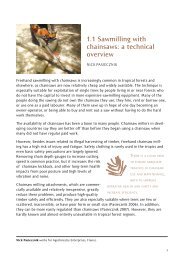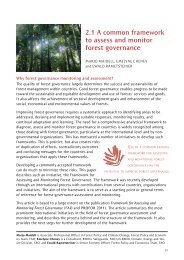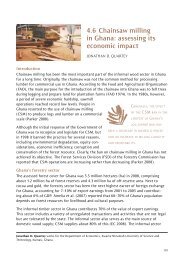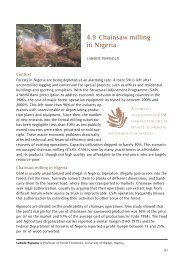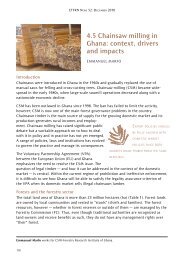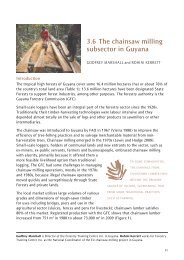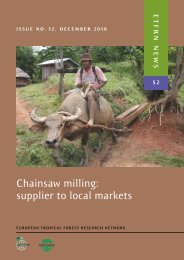Chainsaw milling: supplier to local markets - European Tropical ...
Chainsaw milling: supplier to local markets - European Tropical ...
Chainsaw milling: supplier to local markets - European Tropical ...
Create successful ePaper yourself
Turn your PDF publications into a flip-book with our unique Google optimized e-Paper software.
3.2 chaiNsaw milliNg iN NaTuRal TRopical FoREsTs: a casE sTuDy iN bolivia<br />
The use of chainsaw <strong>milling</strong> techniques can generate good economic returns. The use of<br />
the chainsaw does not demand a large investment. around us$2,000 is needed for equipment<br />
and a small production unit, compared with more than us$200,000 <strong>to</strong> establish a<br />
sawmill. This does not take in<strong>to</strong> account the financial resources needed for exploitation<br />
and processing operation or the operational skills required.<br />
The chainsaw can become an extraordinary <strong>to</strong>ol for development if it is used <strong>to</strong> harvest<br />
and process timber from areas with approved management plans, that are difficult <strong>to</strong><br />
access, or in areas with steep slopes where construction of roads can cause irreversible<br />
damage <strong>to</strong> the ecosystem. The increasing use of chainsaws results in more people becoming<br />
involved. This further degrades the forest and jeopardizes its future productivity.<br />
<strong>Chainsaw</strong> <strong>milling</strong> in public forests and pas, and the subsequent marketing of timber in<br />
<strong>local</strong> <strong>markets</strong>, generates a supply of illegal timber. Together with the failure <strong>to</strong> control<br />
illegal logging, this results in a continuing loss of forest values and governance over<br />
forest lands and pas.<br />
Achieving sustainable development in chainsaw use<br />
The absence of regulations for the purchase and registration of chainsaws, along with<br />
weak regula<strong>to</strong>ry mechanisms, makes chainsaw <strong>milling</strong> activities very difficult <strong>to</strong> control,<br />
especially in situations of poor governance.<br />
The state has invested only in agricultural production systems in the area. This leaves<br />
the forest as an area with no control and often without an owner, which people can enter<br />
freely and alleviate their economic needs. andean migrants consider land areas with<br />
tropical forests as “not worked” and available for conversion <strong>to</strong> other uses, even though<br />
these are not legally allowed.<br />
The control of illegal activities is very difficult, due <strong>to</strong> the remoteness of and lack of<br />
access <strong>to</strong> the areas in question. The major challenge in addressing chainsaw <strong>milling</strong><br />
activities is how <strong>to</strong> implement a control system in an effective and efficient way, with a<br />
commitment from the communities themselves.<br />
acknowledgements<br />
we thank the trust on the part of the <strong>local</strong> people who accompanied us in the field and<br />
the different groups who provided information on chainsaw <strong>milling</strong>, which allowed us <strong>to</strong><br />
assess the stages of wood processing and openly discuss issues inherent <strong>to</strong> such activities.<br />
we also thank Jinke van Dam for assisting us <strong>to</strong> translate this article in<strong>to</strong> English.<br />
71



